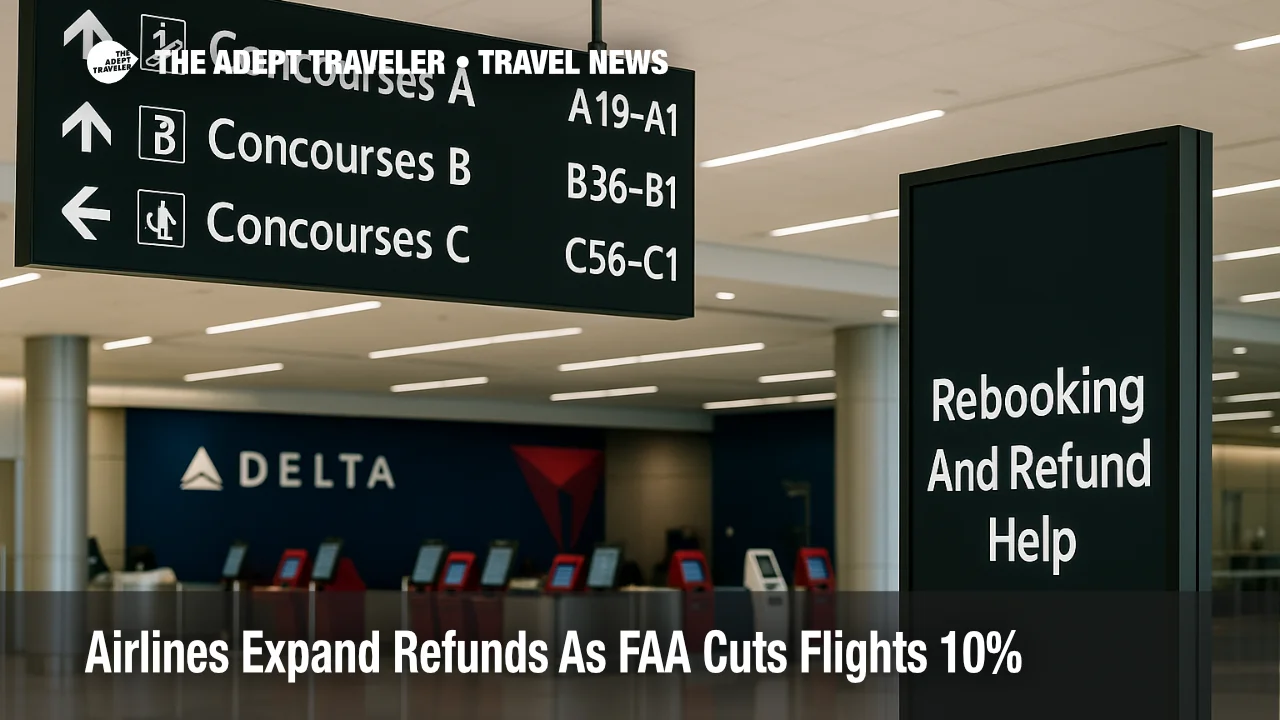Airlines Expand Refunds As FAA Cuts Flights 10%

Key points
- United and American will refund any booked customer during the FAA reduction window
- Delta allows fee-free changes and refunds for itineraries touching affected markets
- Carriers say international long haul is largely protected, regional frequencies trimmed
- FAA's phased reduction begins near 4% on Nov. 7 and ramps to 10% across 40 markets
- Use airline apps and DOT refund rules if your flight is canceled or significantly changed
Impact
- Know Your Options
- United and American refunds apply even if your flight still operates, Delta offers changes or refunds when your trip touches a listed market
- Act Fast In Apps
- Proactive rebookings are rolling out, accept a workable option or switch to earlier flights to reduce risk
- Protect Connections
- Expect trims on regional and point to point legs, avoid tight layovers at hub airports
- International Mostly Intact
- Carriers are prioritizing hub to hub and long haul operations to keep networks stable
- Lean On DOT Rules
- Canceled or significantly changed flights qualify for cash refunds under federal rules
With the FAA imposing a phased cut to air traffic across 40 high-volume markets to address controller fatigue during the shutdown, U.S. airlines are shifting from pure schedule protection to traveler-first flexibility.
United says any customer scheduled to travel during the affected period may request a cash refund even if the flight still operates, and the carrier will focus trims on regional and non-hub-to-hub domestic flying to protect long-haul and hub links.
American has matched broad flexibility, allowing customers whose flights are canceled or who simply prefer not to travel during the window to change or request a refund without penalty. American says it will proactively notify impacted travelers as it adjusts frequencies.
Delta will operate most flights but is reducing schedules in line with the FAA directive and is offering fee-free changes and refunds for itineraries that pass through affected markets. The airline is steering customers to manage options in the app as reaccommodation messages go out.
Behind the policy moves is the FAA's safety-driven reduction, which starts near 4 percent on Friday, November 7, and ramps up to 10 percent as needed across the identified markets. Major hubs are on the list, and airlines emphasize that the vast majority of passengers will still travel as planned.
How to use the policies, step by step
- Wait for the push, then decide: if the airline auto-rebooks you, you can accept, search earlier departures, or invoke the refund option noted above.
- Refund versus rebook: if timing no longer works, United and American will refund, while Delta will refund or change when your trip touches a listed market. Keep receipts only if you decline airline options.
- DOT protections still apply: if your flight is canceled or significantly changed, you are entitled to a cash refund under federal rules, separate from the airlines' voluntary waivers.
What is likely to cancel
Airlines say they are shielding hub-to-hub and long-haul international flying and trimming regional and point-to-point frequencies. That means the most exposed itineraries are short-haul spokes and secondary city pairs, especially at peak hours where traffic metering will be tightest.
Traveler checklist
- Refresh the app twice daily through departure, accept workable rebooks quickly
- Avoid tight connections at the largest hubs this week
- Know the clock: the FAA reduction begins Friday, November 7, and may flex by market
- If plans changed, use the airlines' refund windows, then re-shop alternatives
For additional context on FAA flow programs and why reductions ripple across hubs, see our explainer from November 5 on system-wide traffic management (internal link).
Sources
- An update on the FAA directive - American Airlines Newsroom
- Delta cares for customers, reduces flights beginning Nov. 7 in compliance with FAA directive
- An Update on the Government Shutdown from Scott Kirby to United employees
- FAA reducing air traffic by 10% across 40 'high-volume' markets during government shutdown
- US to cut airline traffic by 10% at 40 airports amid shutdown
- Refunds, U.S. Department of Transportation
- Refunds and Other Consumer Protections, Federal Register
